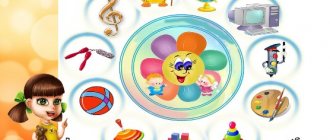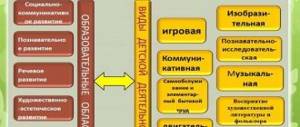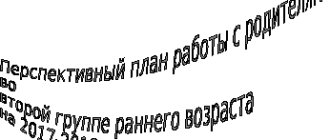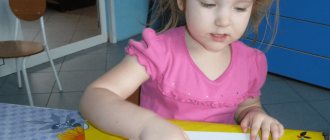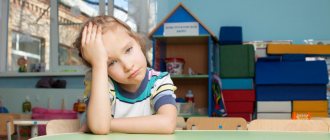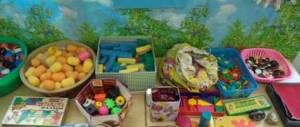The importance of didactic material in kindergarten
The space in which children play should not only be comfortable, clean, bright, but also educational. In this, the teacher is supported by correctly selected didactic materials. They are designed to help the teacher develop the child’s abilities and teach something new. Such materials should fit organically into the interior of the group, complementing and expanding the teacher’s capabilities, creating an atmosphere in which the preschooler wants to play and learn new things.
Didactic materials are auxiliary materials used in the learning process
Didactics (ancient Greek διδακτικός “teaching”) is a branch of pedagogy and educational theory that studies the problems of teaching. Reveals the patterns of assimilation of knowledge, skills and abilities and the formation of beliefs, determines the volume and structure of the content of education.
Wikipedia
Purposes of using didactic materials
Didactic materials are elements of play and creativity, organically integrated into the child’s activities. Pyramids and towers made of cubes are also a kind of didactic material; you just need to join the child’s play, discussing with him the color, shape and size of the toys. Children develop very quickly, so each year has something different. When selecting or creating didactic material, pay attention to the age characteristics and basic needs of children. At different ages, the same didactic material can be used for different purposes.
The purposes of using didactic materials in preschool educational institutions may be the following:
- development of fine motor skills and tactile sensitivity;
- formation of ideas about the external properties of objects (shape, color, size, position in space);
- creating a positive emotional mood;
- development of cognitive processes (memory, attention, thinking);
- development of speech skills;
- teaching numeracy and literacy.
The development of fine motor skills is a priority when teaching younger preschoolers
The use of a variety of didactic materials in kindergarten classes helps to enhance the cognitive activity of preschoolers.
Didactic games in mathematics for older children
Victoria Klishova
Didactic games in mathematics for older children
Didactic games in mathematics for older children
"Pick up a toy"
Goal: to practice counting objects by the named number and memorizing it, to learn to find an equal number of toys.
Content. The teacher explains to the children that they will learn to count out as many toys as he says. the children one by one and gives them the task of bringing a certain number of toys and placing them on one table or another. Other children are instructed to check whether the task has been completed correctly, and to do this, count the toys, for example: “Seryozha, bring 3 pyramids and put them on this table. Vitya, check how many pyramids Seryozha brought.” As a result, there are 2 toys on one table, 3 on the second, 4 on the third, and 5 on the fourth. Then the children are asked to count out a certain number of toys and place them on the table where there are the same number of such toys, so that it can be seen that there are equal numbers of them. After completing the task, the child tells what he did. Another child checks whether the task was completed correctly.
"Pick a figure"
Goal: to consolidate the ability to distinguish geometric shapes: rectangle, triangle, square, circle, oval.
Material : each child has cards on which a rectangle, square and triangle are drawn, the color and shape vary.
Content. First the teacher. suggests tracing with your finger the figures drawn on the cards. Then he presents a table on which the same figures are drawn, but of a different color and size than the children’s , and, pointing to one of the figures, says: “I have a big yellow triangle, what about you?”
Etc. Calls 2-3
children , asks them to name the color and size (large, small of their figure of this type)
.
"I have a small blue square"
.
"Name and Count"
Goal: teach children to count sounds by calling the final number.
Content. It is better to start the lesson by counting toys, calling 2-3 children , then say that the children are good at counting toys and things, and today they will learn to count sounds. The teacher invites the children to count, using their hand, how many times he hits the table. He shows how to swing the right hand, standing on the elbow, in time with the blows. The blows are made quietly and not too often so that the children have time to count them. At first, no more than 1-3 sounds are produced, and only when the children stop making mistakes does the number of beats increase. Next, you are asked to play the specified number of sounds. the children one by one and invites them to hit the hammer or stick against a stick 2-5 times. In conclusion, all children are asked to raise their hand (lean forward, sit down)
as many times as the hammer hits.
"Name your bus"
Goal: to practice distinguishing a circle, square, rectangle, triangle, to find figures of the same shape, differing in color and size,
Content. The teacher places 4 chairs at some distance from each other, to which are attached models of a triangle, rectangle, etc. (brands of buses)
.
Children board the buses (stand in 3 columns behind the chairs. The teacher-conductor gives them tickets. Each ticket has the same figure on it as on the bus. At the “Stop!”
, the children go for a walk, and the teacher swaps the models. At the
“On the bus”
Children find faulty buses and stand next to each other.The game is repeated 2-3 times.
“Is it enough?”
Goal: to teach children to see equality and inequality of groups of objects of different sizes, to bring them to the concept that number does not depend on size.
Content. The teacher offers to treat the animals. He first finds out: “Will the bunnies have enough carrots and the squirrels have enough nuts? How to find out? How to check? Children count the toys, compare their numbers, then treat the animals by placing small toys next to large ones. Having identified the equality and inequality of the number of toys in the group , they add the missing item or remove the extra one.
"Gather a figure"
Goal: learn to count objects that form a figure.
Contents: The teacher invites the children to move a plate with chopsticks towards them and asks: “What color are the sticks? How many sticks of each color? He suggests arranging sticks of each color so that different shapes are obtained. After completing the task, the children count the sticks again. Find out how many sticks went into each figure. The teacher draws attention to the fact that the sticks are arranged differently, but there are equal numbers of them - 4 “How to prove that there are equal numbers of sticks? Children lay out the sticks in rows, one below the other.
"At the Poultry Farm"
Goal: to train children in counting within limits , to show the independence of the number of objects from the area they occupy.
Contents. Educator: “Today we will go on an excursion to a poultry farm. Chickens and chickens live here. There are 6 hens sitting on the top perch, and 5 chicks on the bottom perch. Compare hens and chickens and determine that there are fewer chickens than hens. “One chicken ran away. What needs to be done to get an equal number of hens and chicks? (You need to find 1 chicken and return it to the chicken)
. The game repeats itself. V. quietly removes the chicken, the children look for a mother hen for the chicken, etc.
"Yesterday Today Tomorrow"
Goal: in a playful way, to exercise in the active discrimination of temporary concepts “yesterday”
,
" today
Tomorrow" .
Content. In the corners of the playroom, three houses are drawn with chalk. This is "yesterday"
,
" today
Tomorrow" . Each house has one flat model, reflecting a specific time concept.
Children walk in a circle, reading a quatrain from a familiar poem. At the end they stop, and the teacher says loudly: “Yes, yes, yes, it was... yesterday!”
The children run to the house called
“yesterday”
. Then they return to the circle and the game continues.
“Why doesn’t the oval roll?”
Purpose: to introduce children to an oval shape, to teach them to distinguish between a circle and an oval shape
Contents: Models of geometric shapes are placed on the flannelgraph: circle, square, rectangle, triangle. First, one child, called to the flannelograph, names the figures, and then all the children do this together. The child is asked to show the circle. Question: “What is the difference between a circle and other figures?”
The child traces the circle with his finger and tries to roll it.
V. summarizes the children's : a circle has no corners, but the rest of the figures have corners. 2 circles and 2 oval shapes of different colors and sizes are placed on the flannelgraph. “Look at these figures. Are there any circles among them? One of the children is asked to show the circles. Children's attention is drawn to the fact that on the flannelgraph there are not only circles, but also other figures similar to a circle. This is an oval-shaped figure. V. teaches to distinguish them from circles; asks: “How are oval-shaped figures similar to circles? (Oval shapes also have no corners)
.
The child is asked to show a circle, an oval shape. It turns out that the circle is rolling, but the figure is not oval. (why)
Then find out how an oval shape differs from a circle?
(the oval shape is elongated)
. Compare by applying and superimposing a circle on an oval.
"Count the Birds"
Purpose: to show the formation of numbers 6 and 7, to teach children to count within 7.
Content. The teacher puts 2 groups of pictures (bullfinches and titmice) in one row on a typesetting canvas (at some distance from one another and asks: “What are these birds called? Are they equal? How can I check?”
The child places the pictures in 2 rows, one below the other.
He finds out that there are equal numbers of birds, 5 each. V. adds a titmouse and asks: “How many titmouses are there now? How did you get 6 tits? How much was it? How much did you add? How many has it become? Which birds did you get more? How many are there? Which ones are smaller? How many are there? Which number is greater: 6 or 6? Which is smaller? How to make the birds equally divided into 6. (He emphasizes that if you remove one bird, then there will also be an equal number of 5.)
He removes 1 tit and asks:
“How many are there now?”
How did the number 5 come about ? Again he adds 1 bird in each row and invites all children to count the birds. In a similar way introduces the number 7.
"Stand in Place"
Goal: to train children in finding locations: in front, behind, left, right, in front, behind.
the children one by one , indicates where they need to stand: “Seryozha come to me, Kolya, stand so that Seryozha is behind you. Vera, stand in front of Ira,” etc. Having called 5-6 children , the teacher asks them to name who is in front and behind them. Next, the children are asked to turn left or right and again name who is standing from them and where.
"Where is the figure"
Goal: to learn to correctly name figures and their spatial location: middle, top, bottom, left, right; remember the location of the figures.
Contents. The teacher explains the task: “Today we will learn to remember where each figure is. To do this, they need to be named in order: first the figure located in the center (middle, then top, bottom, left, right.” Calls 1 child. He shows in order and names the figures, their location. Shows to another child. Another child is asked to arrange the figures as he wants, name their location. Then the child turns with his back to the flannelgraph, and the teacher changes the figures located on the left and right. The child turns and guesses what has changed. Then all the children name the shapes and close their eyes. The teacher swaps the places of the shapes. Opening their eyes, the children guess what has changed.
"Sticks in a Row"
Goal: to consolidate the ability to build a sequential series in size.
Content. The teacher introduces the children to the new material and explains the task : “You need to line up the sticks in a row so that they decrease in length.”
.
Warns children that the task must be performed by eye (trying on and rearranging sticks is not allowed)
. “To complete the task, that’s right, each time you need to take the longest stick out of all those that are not laid in a row,” explains the teacher.
Do-it-yourself didactic material for kindergarten
It is quite possible to make didactic materials for kindergarten yourself. The process of creating manuals includes a number of stages:
- The first step in creating visual material is to state the purpose. It is necessary to understand what exactly the developed didactic material will give to children, because the manual must correspond to the age of the students, be understandable and accessible.
- The second step is to select the topic within which the didactic material will be created. For example, in order for a child to learn the name of a color and relate it to a specific object (animal, fruit or object), posters or cards are created on the topic “Primary Colors”.
In this educational game, children remember colors and match them with animal shapes.
- Step three is to think over the concept of the benefit. At this stage of creating didactic material, we should decide what type of visual aid we are creating: cards, a stand, a poster, or perhaps an entire game.
- Step four is to select suitable materials to create a visual aid. There are a number of requirements for didactic materials used in preschool educational institutions:
- The material should be bright so that the child can easily remember what was depicted.
- The material should not be brittle or easily breakable. Young children feel the need to touch everything that interests them, because through touch they learn about the world.
- The material should be as safe as possible for preschoolers, even if they stuff it into their mouths (but this is best avoided).
- The materials used must be hypoallergenic. Preschoolers come to kindergarten with different health indicators, so all items presented for general use must be equally safe for all students.
- The material must withstand sanitary treatment (for example, cardboard or paper is covered with a special film or tape).
- The fifth step is the direct assembly of the material. When creating a visual aid, you need to remember that the information depicted or presented must characterize the world around you and correspond to reality. It is also important that the didactic material made is beautifully and neatly designed; this develops in the child a sense of beauty and the concept of neatness.
Teaching materials should be attractive and neatly designed
- The final step is timely planning for the use of the created didactic material.
Interesting ideas for making teaching materials for preschoolers with your own hands and their detailed description can be found in the article by Oksana Stol.
Do not try to immediately get your child to fully understand the topic. It’s better to go through the topic several times, using different didactic material, thereby reinforcing it.
Photo gallery: didactic materials for the development of fine motor skills
To make such a manual you will need laces and large buttons.
This didactic material develops in children the concepts of whole and part.
Kids enjoy making images from pieces of felt.
Games with clothespins develop fine motor skills and color perception of younger preschoolers
This manual was created to develop children's fine motor skills, thinking and handling office supplies.
Photo gallery: didactic materials on mathematics
Games with paper clips develop counting skills
Such cards will help children remember numbers and also develop tactile sensitivity.
This material can be used both to develop counting skills and to study basic colors.
Photo gallery: didactic materials on studying the world around us
A laptop is a homemade book with educational materials and games on a specific topic.
With the help of this material, preschoolers study natural phenomena that occur during spring, and also master the concepts of time, actions and movements
With the help of such chips you can study the composition of certain dishes.
This guide helps children understand what the seasons are, when the seasons change and how nature changes.
The purpose of this manual is to reinforce the concepts of one-many, big and small and learn the names of edible mushrooms
Card index of games with goals according to the Federal State Educational Standard
"Correct account"
Purpose: It is necessary to provide assistance in understanding the order of numbers in the natural series. The teacher offers a ball as a material.
Contents: children stand in a circle. Before you begin, you need to agree in advance in what order (direct or reverse) they will count. After which you can throw the ball and name the number. The one who catches the ball must continue to count, throwing the ball to his partner.
"Who where"
Goal: The position of products that are in space should be correctly determined. To differentiate objects, the teacher provides toys.
Description: All material must be placed in different places. After this, the teacher asks which toy is in front, behind, nearby, far away.
"A lot and a little"
Purpose: To help understand the concepts of “many”, “few”, “one”, “several”, “more”, “less”, “equally”.
Contents: Ask to talk about single products, of which there are many or few. For example: many books, one chair, many people. You can arrange cards of different shades. Blue cards are 8, and yellow cards are 4. Then the teacher should ask which cards are more and which are fewer.
Method of conducting classes
Related videos
The videos presented below contain a visual embodiment of ideas for creating teaching materials in kindergarten. After familiarizing yourself with them, you can independently make interesting and useful gaming aids for preschoolers.
Video: DIY didactic games
Video: do-it-yourself didactic math games for kindergarten
Video: didactic materials for teaching literacy
https://youtube.com/watch?v=xKDbYhAEmLA
Video: examples of didactic aids on the sensory development of children
https://youtube.com/watch?v=JOKWuUwiXf8
Video: how to make a flannelgraph
The use of didactic materials in kindergarten helps to develop the cognitive, communicative and creative abilities of preschoolers of all age groups. When applying benefits, the teacher should remember the wide range of choices for their presentation. Making didactic materials with your own hands allows you to implement various pedagogical ideas in the educational process of a preschool educational institution. The main thing is to correctly develop the manuals, think them through and execute them. A variety of methodological recommendations and the author’s own imagination will help with this.
Why is this necessary, what are the tasks of teaching mathematics to preschoolers
Cartoon and fairy-tale characters that kids love so much can become a motivating element when mastering mathematical concepts. Many heroes come to visit children (toy or picture), bringing with them coloring pictures, geometric shapes, symbolic souvenirs (there should be as much clarity as possible). Preschoolers develop a keen interest in mathematics.
Important! Before starting a gaming mathematical lesson, it is necessary to integrate cognitive activity into other types. For example, you can choose the right musical composition (best moving).
One of the goals of preschool educational institutions (PEIs) is the formation of initial mathematical concepts and concepts. The child must be able to navigate the abstract world of numbers, quantities, and time periods that is difficult for children to understand. Work on teaching mathematics to children who attend kindergarten is carried out consistently and purposefully, becoming more complex from year to year, which is reflected in educational programs.
The role of didactic classes on FEMP
Methodology for conducting classes on FEMP in the middle group
The main task is to develop a child’s cognitive interest in mathematics. Children need to improve their socialization skills. To this end, the teacher must choose a relaxed environment for communicating with each other.
Note! The main technique in math classes is an unexpected turn of events. For example, a teacher presents activities related to children’s favorite fairy-tale characters or animals.
An equally pleasant surprise is the non-standard reception. For example, the teacher asks the child to find a certain object that is hidden in the room or solve a riddle. The main goal of the teacher is to create intrigue to attract the child's interest.
Taking into account all the requirements of the Federal State Educational Standard, educational classes can be organized. For example, it is difficult for a mother squirrel to decide how many mushrooms and berries she needs to collect to take to her children.
Play is a great joy for a preschool child, while at the same time developing important mental processes (thinking and attention, memory and speech). While playing, a child gains new knowledge and skills, often without even realizing it. Conducting mathematical classes develops children intellectually and increases their cognitive interest. In addition, such activities are useful for the socialization of preschoolers - it teaches them to communicate with each other and the teacher.
